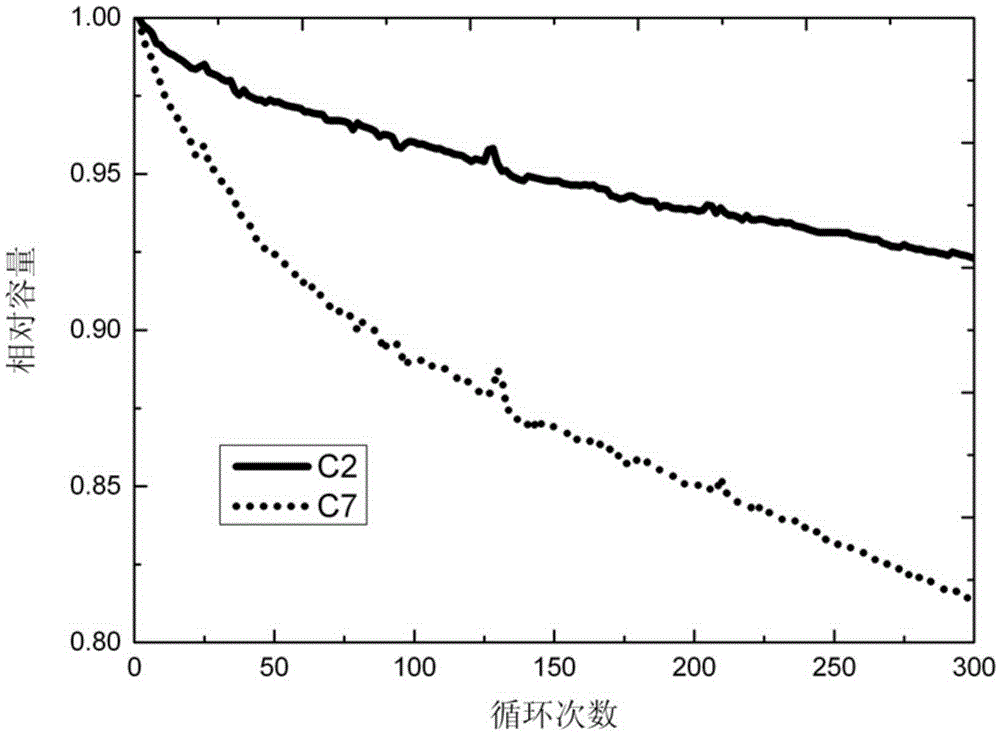Negative electrode material for lithium ion battery, lithium ion battery negative electrode sheet and lithium ion battery
A technology for lithium-ion batteries and negative electrode materials, applied in battery electrodes, secondary batteries, circuits, etc., can solve the problems of poor thickening effect, affecting the electrochemical performance of lithium-ion batteries, and the decline of active materials
- Summary
- Abstract
- Description
- Claims
- Application Information
AI Technical Summary
Problems solved by technology
Method used
Image
Examples
Embodiment 1
[0044] Preparation of negative electrode sheet N1: mix natural graphite, styrene-butadiene rubber, konjac glucomannan, conductive carbon black and water according to the ratio of 99.5:0.2:0.05:0.25:120, and stir at a high speed to obtain uniform dispersion to make negative electrode slurry. The negative electrode slurry was evenly coated on both sides of the copper foil, dried, and compacted by a roller press to obtain the negative electrode sheet, which was designated as N1. The molecular weight of konjac glucomannan is 2000000Da. The molecular weight of styrene-butadiene rubber is 100000Da.
[0045] Preparation of the positive electrode sheet P1: Lithium cobaltate, polyvinylidene fluoride, conductive carbon black and N-methylpyrrolidone according to the ratio of 90:5:5:20, were uniformly dispersed by high-speed stirring to prepare the positive electrode slurry. The positive electrode slurry was evenly coated on both sides of the aluminum foil, dried and compacted by a rolle...
Embodiment 2
[0048] Preparation of negative electrode sheet N2: Mix artificial graphite, styrene-butadiene rubber, konjac glucomannan, conductive graphite and water according to the ratio of 99:0.4:0.1:0.5:110, stir at high speed to obtain uniform dispersion to make negative electrode slurry, and The negative electrode slurry is evenly coated on both sides of the copper foil, dried and compacted by a roller press to obtain the negative electrode sheet, which is recorded as N2. The molecular weight of konjac glucomannan is 1600000Da. The molecular weight of styrene-butadiene rubber is 120000Da.
[0049] Preparation of the positive electrode sheet P2: Lithium manganate, polyvinylidene fluoride, conductive carbon black and N-methylpyrrolidone according to the ratio of 92:4:4:30 were uniformly dispersed by high-speed stirring to prepare the positive electrode slurry. The positive electrode slurry was evenly coated on both sides of the aluminum foil, dried, and compacted by a roller press to o...
Embodiment 3
[0052] Preparation of negative electrode sheet N3: Mix surface-modified natural graphite, styrene-butadiene rubber, konjac glucomannan, vapor-phase grown carbon fiber and water according to the ratio of 96:1.6:0.4:2:100, and stir at a high speed to obtain uniform dispersion. Contains the negative electrode slurry, the negative electrode slurry is evenly coated on both sides of the copper foil, dried and compacted by a roller press, and the negative electrode sheet is recorded as N3. The molecular weight of konjac glucomannan is 1200000Da. The molecular weight of styrene-butadiene rubber is 140000Da.
[0053] Preparation of the positive electrode sheet P3: Lithium nickel manganese oxide, polyvinylidene fluoride, conductive carbon black and N-methylpyrrolidone according to the ratio of 94:3:3:40 were uniformly dispersed by high-speed stirring to prepare the positive electrode slurry. The positive electrode slurry was evenly coated on both sides of the aluminum foil, dried and c...
PUM
| Property | Measurement | Unit |
|---|---|---|
| Molecular weight | aaaaa | aaaaa |
| Molecular weight | aaaaa | aaaaa |
| Molecular weight | aaaaa | aaaaa |
Abstract
Description
Claims
Application Information
 Login to View More
Login to View More - R&D
- Intellectual Property
- Life Sciences
- Materials
- Tech Scout
- Unparalleled Data Quality
- Higher Quality Content
- 60% Fewer Hallucinations
Browse by: Latest US Patents, China's latest patents, Technical Efficacy Thesaurus, Application Domain, Technology Topic, Popular Technical Reports.
© 2025 PatSnap. All rights reserved.Legal|Privacy policy|Modern Slavery Act Transparency Statement|Sitemap|About US| Contact US: help@patsnap.com

